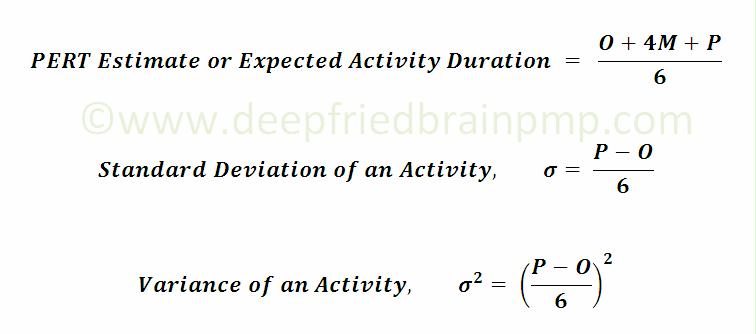PERT and CPM get Cozy
 Project Estimation and PERT (Part 6): If you have been following the series on PERT, then you have developed a good understanding of probability and statistical concepts as applied to projects. In this post, we are going to see how Program Evaluation and Review Technique (PERT) and Critical Path Method (CPM) come together in estimating the total project duration. PERT is a probabilistic method, whereas CPM is deterministic. PERT estimates the activity durations based on probability, whereas CPM assumes that the activity durations are fixed. We’ll take a sample project and work through it to understand the concepts.
Project Estimation and PERT (Part 6): If you have been following the series on PERT, then you have developed a good understanding of probability and statistical concepts as applied to projects. In this post, we are going to see how Program Evaluation and Review Technique (PERT) and Critical Path Method (CPM) come together in estimating the total project duration. PERT is a probabilistic method, whereas CPM is deterministic. PERT estimates the activity durations based on probability, whereas CPM assumes that the activity durations are fixed. We’ll take a sample project and work through it to understand the concepts.
Using PERT Estimate to calculate Critical PathPermalink
We know that the activity duration is a random variable, and its values follow a probability distribution function and are NOT fixed. Using the PERT formula, we calculate the expected duration of each activity on the network diagram. However, in order to calculate the critical path of a project using the CPM, we need to treat the activity duration estimates as fixed. By assuming fixed activity durations, we can determine the critical path of the project using CPM.
Let’s work with an example to understand how this works. Suppose we have 4 activities A, B, C and D on the critical path. For each of these activities, the Optimistic (O), the Most Likely (M), the Pessimistic (P) and the PERT estimates along with their Standard Deviations (σ) and Variances (σ^2) are shown in the following table. The durations are in days.
| Activity | O | M | P | PERT | σ | σ^2 |
|---|---|---|---|---|---|---|
| A | 7 | 10 | 13 | 10.0 | 1.000 | 1.000 |
| B | 6 | 8 | 16 | 9.0 | 1.666 | 2.777 |
| C | 6 | 12 | 15 | 11.5 | 1.500 | 2.250 |
| D | 10 | 17 | 30 | 18.0 | 3.333 | 11.111 |
| 48.5 | 17.138 |
If you have been following the series on PERT, then you know the formulas by heart, but let me give you a quick recap:

The total expected project duration, 48.5 days, is calculated by adding the PERT estimates of the activities on the critical path. But wait, did you notice something strange here? If the duration of individual activities are random variables (not fixed), then how can the duration for the entire project be fixed? It has to be a random variable too and follow a probability distribution function. Don’t you think so?
In Probability and Statistics in Projects we learned that PERT assumes that the individual activity durations are random variables and follow the beta distribution. However, if all the activities on the critical path have the same distribution and are independent of each other, and the number of activities (on the critical path) are large enough (30+), we can apply the Central Limit Theorem (CLT) to simplify matters.
Standard Deviation of the Project
CLT says that even though the individual activity durations follow the beta distribution (or any other distribution), when they are added up, the resulting distribution (of project duration) is Normal. Moreover, the variance of the project durations can also be calculated by adding up the individual activity duration variances. By taking the square root of the variance of the the project duration, we can get the standard deviation of the project duration.
The standard deviation can be used to calculate the probability of completion of a project by a given date or in a given time.
In practice, applying the CLT to a project similar to our example project would be inappropriate, as the number of activities on the critical path are very few (only 4 in our case). For CLT to be applicable, we need at least 30 activities on the critical path. There are several other limitations of PERT that we’ll discuss in a follow-up article. For the sake of simplification, we’ll assume that CLT applies here. Therefore, the project duration can be assumed to follow the normal distribution with an expected value of 48.5 days, a total variance of 17.138, and a standard deviation of 4.14 (square root of 17.138).
Trivia: If the project duration is in days, then what is the unit of standard deviation and variance?
Note: Adding the individual expected activity durations gives the total expected duration of the project. Similarly, adding the individual activity duration variances gives the total project duration variance. BUT, adding the standard deviations of the individual activity durations does not give the standard deviation of the total project duration. The standard deviation of the project duration is calculated by taking the square root of the total project duration variance.
Let’s summarize the steps:
- Get the 3 point estimates - Optimistic, Most Likely, Pessimistic - for each activity on the network diagram.
- Determine the PERT estimate (expected duration) for each activity on the network diagram.
- Assuming that the PERT estimate of each activity is of fixed duration, identify the critical path of the project.
- Add the PERT estimate for each activity duration on the critical path to determine the expected project duration.
- Calculate the standard deviation of the duration of each activity on the critical path.
- Calculate the variance of the duration of each activity on the critical path, by squaring the standard deviations.
- Add the variance of the duration of each activity on the critical path to determine the variance of the expected project duration.
- Take the square root of the variance of the expected project duration to get the standard deviation of the expected project duration.
By using the standard deviation of the expected project duration, we can get the confidence level or probability of completing the project on a given date or in a given time. This is precisely the subject of the next article. Hasta la vista.
8-part series on Project Estimation and PERT
- Get Intimate with PERT
- Three Point Estimate - The Power of Three in Project Estimation
- What is PERT?
- The Magical PERT Formula
- Probability and Statistics in Project Management
- PERT and CPM get Cozy (you are here)
- PMP Quiz Contest - Activity Duration Estimates
- Standard Deviation and Project Duration Estimates
Image credit: Flickr / jelene
10 Comments
Aviad Sar-Shalom
Harwinder Singh
Sreekanth
Harwinder Singh
Anonymous
Harwinder Singh
Anonymous
Harwinder Singh
Anonymous
Harwinder Singh